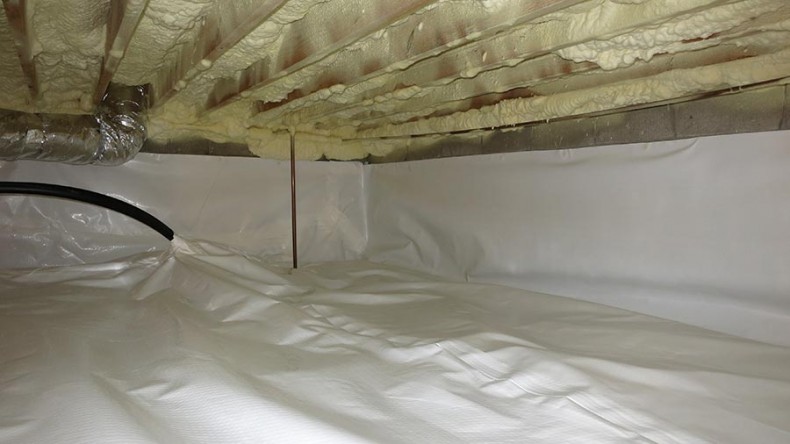To seal or not to seal
By Bret Curry
A properly sealed crawlspace with rigid moisture barrier and foam insulated floor.
To seal or not to seal the crawl space is a recurring dilemma for many homeowners.
To begin, why do homes have crawl spaces? Crawl spaces came along when concrete block foundations were introduced. They cost less to build than basements, and they provide access to plumbing, ductwork and some electrical components. Decades ago, conventional wisdom introduced vents, and it was believed they would keep the crawl space area dry. The vents, however, introduced a few unintended consequences.
Years of field practice by industry experts yielded a better understanding of building science. Diagnostic equipment, monitors for relative humidity and dew point, and infrared cameras have unveiled some compelling facts about crawl spaces. In fact, many builders across the country who understand building science are no longer building vented crawl spaces, and some building codes are even changing to accept properly sealed crawl spaces.
Outside air and moisture
Experience has taught us that a properly sealed crawl space with a properly installed moisture barrier will dramatically reduce unwanted moisture and thwart heat gain and loss. Proper air and moisture sealing improves comfort and reduces heating and cooling costs. Additional benefits are the elimination of the earthy smell inside a home caused by a damp crawl space and elimination of the environment that promotes the growth of mold and mildew. And floors will be warmer during the winter. Also, properly sealed crawl spaces can be used for storage.
Many existing homes with vented crawl spaces can be retrofitted and sealed if they meet some very important criteria.
First, let’s address how nature affects the crawl space. Remember that heat moves to cool on our wonderful planet. On a summer day, our nice cool crawl space becomes an attraction for hot and humid air. The hot air moves through the vents to the cooler crawl space causing everything to become warmer — even the ductwork and floors. If the ground is not properly covered with a moisture barrier, water vapor from the ground and air will condense on cooler surfaces. This is why most ductwork located in vented crawl spaces has evidence of condensation with mold and mildew on the outer side of the insulation. Uninsulated ducts may show signs of rust and corrosion. The opposite happens during the winter. The warmer air under the floor escapes through the foundation vents. This causes the floors to become quite cold, and could cause pipes to freeze and break in extreme cold.
Are you ready to seal it?
If you can answer “yes” to these questions about your crawl space, you are a candidate for sealing:
- Is your crawl space dry year-round without any standing or recurring drainage problems?
- Is your home free from any plumbing leaks?
Sealing a crawl space is not that difficult, but it does take time to properly complete the job. A rigid moisture barrier is paramount. There are companies that sell quality watertight moisture barriers and special mastics and tapes to assure an airtight and waterproof seal. Foam board can be used for sealing the inner side of the vents.
If you live in an area where radon could be an issue, I suggest contracting with an authorized entity to handle your project. Also, if you live in an area where termites exist and insurance is required, I suggest that you contact your policyholder and inquire about parameters concerning sealed crawl spaces. They may require a gap between the top of the moisture barrier and the band joist for inspection purposes. Many termite companies now offer this service.
About the Author
Bret Curry is the residential energy manager for Arkansas Electric Cooperative Corporation.-
Share this story:




